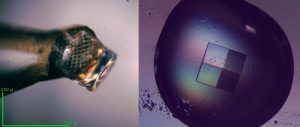Protein crystals are so sensitive, that diffraction experiment conducted in room temperature could easily damage them. Therefore, an important preparation step for diffraction experiment is cooling protein crystals to around 100K.
Water is significant part of protein crystals (even to 80%) and it’s a really love-hate relationship. On the one hand, high solvent content provides native environment for protein. Nevertheless, at the same time, during the cooling, water can cause crystals cracking (due to ice formation) or difficulties during diffraction data collection (because of visible ice rings on diffraction pattern). To avoid that, prior to the cooling, the crystals have to be treated using so-called cryo-protectants.

Tetragonal crystals of hen egg-white lysozyme during data collection (left picture) and in crystallization drop (right picture).
In my project, I would like to investigate the effect of Deep Eutectic Solvent (DES), based on trehalose and choline chloride, as a potential cryo-protectant for protein crystals.
 Ela Wator, molecular biotechnology student from Cracow (Poland), summer student in HZB MX-group at BESSY II
Ela Wator, molecular biotechnology student from Cracow (Poland), summer student in HZB MX-group at BESSY II

Very well explained, and with a nice metaphor. A good example how with a bit of fantasy you can make a difficult topic interesting to a wider audience.
Method for data collection is of course x-ray diffraction. Before diffraction experiment crystals have to be fished with small loops and then mounted on the goniometer (what you can see in the picture). 🙂
The picture of data collection seems very interesting to me. Would like to understand what you mean. How is the method for this data collection?
Amazing crystals! I can’t wait to see your presentation!
Sounds good! I would like to hear more.
I’d like to hear about it!